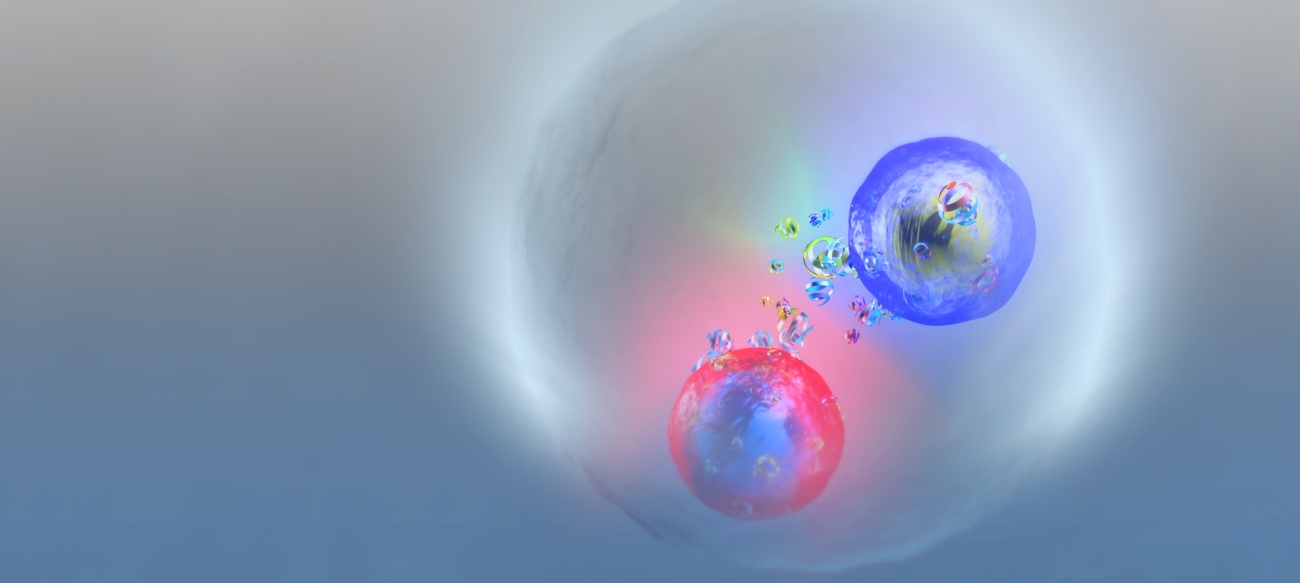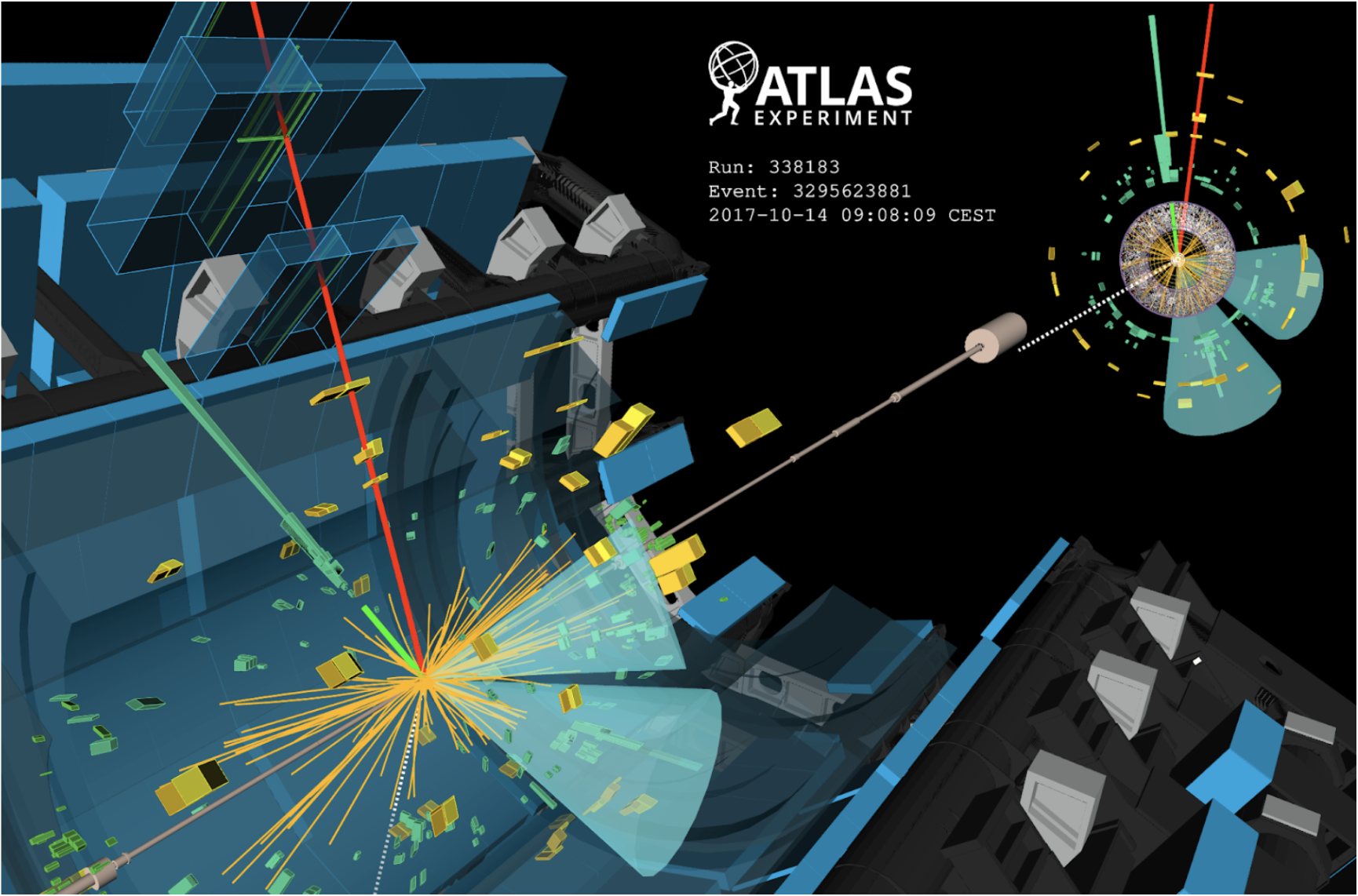Bound state, found state - ATLAS ties the knot on top quark pair production at threshold

Physics at the LHC often advances by pushing into regimes once thought unreachable. One such frontier is the precise study of top-anti-top quark pairs (tt̄) near the production threshold, where subtle quantum effects may leave their imprint.
A few months back, colleagues from the CMS experiment reported in this Newsletter [1] on an intriguing excess of events in the LHC Run 2 dataset, interpreted either in terms of heavy resonance models [2] or the possible formation of “toponium” states [3]. That observation challenged long-standing assumptions that quasi-bound states of the top quark could not be accessed at the LHC.
The ATLAS Collaboration is pleased to report that it has now performed an independent study of this kinematic region using the full Run-2 dataset of 140 fb-1 at √s = 13 TeV [4]. The results confirm and strengthen the emerging picture: when compared with perturbative QCD (pQCD) alone, the data reveal a significant enhancement at the threshold, consistent with the formation of short-lived quasi-bound tt̄ states.

Event display of a candidate event consistent with the formation of a tt̄ quasi-bound-state. The event (Run number 338183 Event number 3295623881, recorded on October 14, 2017) is selected based on properties of the tt̄ pair. In particular, the invariant mass of the tt̄ pair in the event is 342 GeV, and the values of the spin-sensitive observables chel and chan are 0.97 and 0.94, respectively. The mass of the top (antitop) in the event is 167 GeV (172 GeV), and the magnitude of the top momentum in the top-quark pair rest frame, p*, is 25 GeV.
In this 3D cut-away view of the ATLAS detector, several radial sectors have been removed to expose the interior. In this event, each top quark decays into a b quark and a W boson. The two W bosons then decay leptonically: one into an electron (green line) and an electron neutrino, and the other into a muon (red line) and a muon neutrino. The neutrinos are represented by the missing energy in the event, shown as the dashed white line. The event contains two jets from the b-quarks, shown as turquoise cones. Tracks of charged particles reconstructed in the inner detector, and with transverse momentum greater than 1 GeV, are visualised as orange lines. Green/teal rectangles correspond to energy deposits in cells of the electromagnetic calorimeter, while yellow/orange rectangles correspond to energy deposits in cells of the hadron calorimeter. Muon chambers in the barrel region are shown as semi-transparent blue boxes; inside them, the measurements associated with the muon are shown as green lines. The top-right inlay presents a transverse-plane projection of the same event, showing the electron (green line) and muon (red line) tracks and the direction of the b-tagged jets (turquoise cones) and missing energy (dashed white line). Starting from the center, the radial view shows the hits in the Pixel (white dots), SCT (yellow), and TRT (white/red) detectors. Image source.
The top quark’s fleeting lifetime (~5x10-25s) precludes it from hadronising in the conventional sense: unlike in the lighter quarkonia (incidentally, the J/ѱ charmonium state was discovered almost exactly 50 years prior the announcement of the CMS excess [5]), toponia are characterised by the spontaneous electroweak decay of one of the two top quarks involved. Theoretical work in non-relativistic QCD (NRQCD) indicates that the few top quarks “lucky” enough to live longer than the top average lifetime might still feel a strong enough attractive potential to form colour-singlet quasi-bound states. Rather than a narrow resonance, such states would appear experimentally as a broad local enhancement in the invariant mass spectrum just below twice the top quark mass (~345 GeV).
ATLAS had already pointed to unusual dynamics close to threshold, searching for and observing quantum entanglement in dileptonic tt̄ events [6]. CMS had reported a similar observation in [7], with the first hints that quasi-bound state effects, for the most part not accounted for in the pQCD Monte Carlo simulations, could play a role.

Pre-fit distributions of mtt̄ in the nine signal regions (upper panel), together with a comparison between the tt̄ quasi-bound-state prediction and the data, from which the pQCD tt̄ contribution and background processes have been subtracted (middle panel), and the ratio of the data and the extended tt̄ model including tt̄NRQCD contributions (lower panel). The error bars on the data markers represent the statistical uncertainty of the measurement, while the gray hashed and shaded bands represent the total systematic uncertainty in the prediction. Image source.
In this new preliminary analysis [4], ATLAS has focused on the threshold region. In the dileptonic tt̄ decay channel, which provides a very clean but kinematically challenging signature, only events with invariant mass mtt̄ < 500 GeV were retained. This allows to separate threshold effects from higher-mass pQCD continuum behaviour, and to scrutinise the systematics model further. To reconstruct the full tt̄ system despite the presence of two undetected neutrinos, a constrained geometric method was employed that leverages the known top and W masses, as well as the measured missing transverse energy. An mtt̄ resolution of about 20% is obtained, sufficient to distinguish broad structures.
To sharpen sensitivity, the dataset was further divided into nine categories based on two angular observables previously exploited in the quantum entanglement measurement and in the CMS analysis. These observables probe spin correlations in the tt̄ system, which differ markedly between open pQCD production and spin-singlet quasi-bound states. The analysis combined mass and spin information as complementary handles on the toponium physics.
A state-of-the-art simulation of these toponium effects was obtained from collaboration with theorists [8]. By computing the leading-order Green’s function associated with the NRQCD potential for the colour-singlet S wave, a suitable kinematic reweighting of Monte Carlo tt̄ events was obtained. An alternative, simplified signal model relies instead on the approximation of toponium as a pseudo-scalar Breit-Wigner resonance, with appropriately tuned parameters; this model, used by CMS, was part of the extensive series of cross-checks performed in this ATLAS analysis.
The data reveal a clear excess of events over the baseline pQCD prediction (which includes NNLO QCD and NLO electroweak corrections), concentrated near threshold and compatible with expectations for toponium formation. The measured cross section is somewhat larger, by just about two standard deviations, than current NRQCD predictions, though theoretical uncertainties remain substantial. It is also in very good agreement with the cross section reported by CMS. Alternative fits using the simplified signal model or different Monte Carlo generators for open pQCD tt̄ production all found the data to be incompatible with the absence of a quasi-bound state component.
This observation of a tt̄ threshold enhancement by both experiments marks an important milestone in top quark physics, and cements once more the LHC as a remarkable precision machine. The implications are wide-ranging, from studying QCD with high masses in the non-relativistic regime, to probing electroweak symmetry breaking via the top quark Yukawa coupling, and refining our understanding of interference and off-shell effects in the decay of top quarks. Run 3 data promise a dramatic increase in statistics and will enable more differential studies. More than ever, the interplay between experiment and theory is crucial in further scrutinising this excess and pushing the precision frontier.
Further Reading
- A. Grohsjean and L. Jeppe, “Anomaly at the Threshold: A Closer Look at tt̄ Events in CMS”. CERN EP Newsletter, 24 June 2025 .
- CMS Collaboration, “Search for heavy pseudoscalar and scalar bosons decaying to a top quark pair in proton-proton collisions at √s = 13 TeV”. arXiv:2507.05119 [hep-ex].
- CMS Collaboration, “Observation of a pseudoscalar excess at the top quark pair production threshold”. Rep. Prog. Phys. 88 (2025) 087801 .
- ATLAS Collaboration, “Observation of a cross-section enhancement near the tt̄ production threshold in √s = 13 TeV pp collisions with the ATLAS detector”. ATLAS-CONF-2025-008 .
- J. Ellis, “Personal Memories of 50 Years of Quarkonia”. arXiv:2506.10643 [hep-ph].
- ATLAS Collaboration, “Observation of quantum entanglement in top-quark pairs using the ATLAS detector”. Nature 633 (2024) 8030 .
- CMS Collaboration, “Observation of quantum entanglement in top quark pair production in proton–proton collisions at √s = 13 TeV”. Rep. Prog. Phys. 87 (2024) 117801 .
- B. Fuks et al., “Simulating toponium formation signals at the LHC”. Eur. Phys. J. C 85 (2025) 157 .
